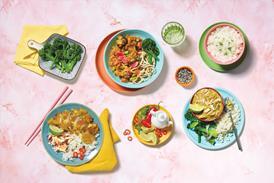The trend to buy "green" runs hand in hand with the trend to buy premium - thanks chiefly to the price tag. But there is only so much shoppers are prepared to pay, which could limit the growth prospects of so-called green categories. This was one of the messages to emerge from the Corporate Responsibility in the Food Industry conference organised by Agra Informa in London this week, echoing the findings of Chrysalis Radio's survey (see News p14).
Edward Garner, communications director at TNS Worldpanel - UK, says that on the one hand, the demand for premium, including free range, organic and Fairtrade, is on the rise.
Yet on the other, expenditure on food and drink has fallen from 24% to 8% since 1970: "We're two and a half times more wealthy than we used to be yet the response of the food industry has been to make itself less important."
This might make sense if consumers were buying purely on price, but they're not, he says, highlighting the growth in demand for premium breads such as Warburtons: "Tesco's Value range is moving up, yes, but what's more interesting is what's happening to ranges like Finest and Taste the Difference," he says. "They're brands in their own rights now."
There is a strong link between the propensity to buy premium and green ranges, both of which are currently the preserve of the AB shopper, he argues, citing data showing Tesco Finest shoppers think of themselves of food connoisseurs and are prepared to pay more for quality ingredients, but also try to support regional food producers and are prepared to pay more for organic and free range.
He also highlights Waitrose's performance in organic. It over-indexes the average market share almost fivefold. Sainsbury's, too, punches above its weight, prompting him to describe it as a "slightly diluted Waitrose."
However, he warns, the success of free-range eggs and organic babyfood does not necessarily mean that other "green" categories will see a similar transition into the mainstream. Where the price disparity is greater between the green and the standard product, the propensity to buy green is much lower, he says. Get the quality wrong and it is lower still.
Hilary Parsons, head of corporate affairs at Nestlé SA, agrees consumers' primary considerations remain product quality and reliability. Even so, she acknowledges their growing interest in green issues and accepts that it is beholden to large companies like Nestlé to "make a positive societal contribution, treat workers well and build trust in your brand".
Judith Batchelar, director of Sainsbury's brand, adds that health is playing just as much of a role in driving "green" food sales as overtly green concerns about the environment or ethical sourcing. "Health and obesity are the biggest issues. Customers are increasingly motivated by it. The customer's definition of health has changed - it extends to organic."
Sainsbury's has taken advantage of the synergies between health and green issues to pursue a "health by stealth" strategy, she says. "There's a definite halo effect." Even so, she adds, it is the retailer's responsibility to help consumers by editing their choices: "Let's change behaviour first and hope attitudes follow."
That's already beginning to happen, she suggests. Garner, however, feels there's a long way to go before green goes mainstream: "Despite the warm feelings people have for many of these categories, there are a helluva lot of people for whom this is irrelevant."














No comments yet